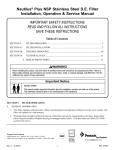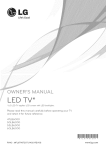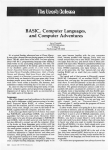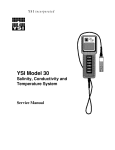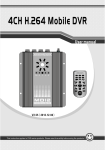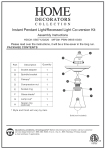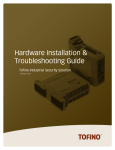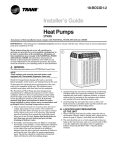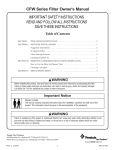Download Nautilus™ NS Stainless Steel D.E. FilterInstallation, Operation
Transcript
Nautilus™ NS Stainless Steel D.E. Filter Installation, Operation & Service Manual IMPORTANT SAFETY INSTRUCTIONS READ AND FOLLOW ALL INSTRUCTIONS SAVE THESE INSTRUCTIONS Table of Contents SECTION I. FILTER OPERATION. .................................................................................................... 1 SECTION II. FILTER INSTALLATION. .............................................................................................. 3 SECTION III. TECHNICAL DATA ............................................................................................. 10 - 11 A. REPLACEMENT PARTS ............................................................................................... 10 - 11 SECTION IV. TROUBLE SHOOTING ............................................................................................... 12 SECTION V. MANUAL AIR RELIEF VALVE ADDENDUM ........................................................... 13 SECTION VI. NAUTILUS FNS & NS FILTERS REPLACEMENT KIT ............................................ 14 WARNING Before installing this product, read and follow all warning notices and instructions accompanying this filter. Failure to follow safety warnings and instructions can result in severe injury, death, or property damage. Call (800) 831-7133 for additional free copies of these instructions. Important Notice Attention Installer. This manual contains important information about the installation, operation and safe use of this product. This information should be given to the owner/operator of this equipment. SECTION I. FILTER OPERATION. WARNING This filter operates under pressure. When closed properly and operated without air in the water system, this filter will operate in a safe manner. Warning labels should be affixed to the top of the filter and on the clamp bands at all times. Keep safety labels in good condition. Replace missing or damaged safety labels. (For free labels call: 1-919-774-4151 or 1-805-523-2400.) Pentair Pool Products 1620 Hawkins Ave., Sanford, NC 27330 • (919) 774-4151 10951 West Los Angeles Ave., Moorpark, CA 93021 • (805) 523-2400 Rev. B 5-14-01 R MEMBER NATIONAL SPA & POOL INSTITUTE 1 P/N 191600 A. HOW YOUR FILTER WORKS Your vertical grid diatomaceous earth (D.E.) filter is designed to operate for years with proper maintenance. The filter housing is made of corrosion resistant materials and when installed, operated and maintained in accordance with these instructions, your filter will provide years of service. An External Air Relief Valve has been factory installed for you safety. Your filter is charged with D.E. at initial start-up. This D.E. will cover the vertical filter grid cloth within the filter with a thin coating. Dirty water flows from the pool through the control valve on the side of the filter and into the lower side connection of the filter (Item 30). The dirty water flows through the vertical grid elements (Item 17) where dirt is filtered out by the D.E. coating. All grid elements channel cleaned water into a manifold system (Item 13) which exits at the upper side connection (Item 26) and through the control valve to return back to the pool. By Filter is designed and intended for use to filter diluting the dirty pool water with clean water, the entire pool becomes gradually water in swimming pools and spas. cleaned. Your filter and pump should be sized to circulate from 2 to 4 times the volume of water in the entire pool through the filter every day to accomplish the cleaning. As dirt is collected in the coating of D.E. in the filter, the pressure will rise and the flow of water to the pool will be reduced. See other sections in the manual to determine when to clean the filter and how to choose the appropriate cleaning method. CAUTION This filter will only remove suspended matter and does not sanitize the pool. The pool must be sanitized and pH balanced for sparkling clear water. Your filtration system must be configured and sized to meet your local health codes. NOTE Part no's in parenthesis refer to the replacement parts as shown in the exploded drawing on page 11 of this manual. WARNING Failure to operate your filter or inadequate filtration can cause poor water clarity that could obstruct visibility in your pool and can allow diving in shallow pool area, or diving into or on top of obscured objects which can cause serious bodily injury or drowning. Clear water is the result of proper filtration as well as proper water chemistry. Pool chemistry is a specialized area and you should consult your local pool service specialist for specific help or instructions. In general proper pool sanitation requires a free chlorine level of 1 to 2 PPM and a pH range of 7.2 to 7.6. FILTER OPERATIONAL DATA FLOW RATE (GPM) FILTER MODEL NUMBER FILTER MODEL (Sq. Ft.) NS 24 24 36 NS 36 36 NS 48 TURNOVER CAPACITY - (GALLONS) (Based on 2.0 GPM / Sq. Ft.) Public Residential 1.5 GPM / Sq. Ft. 2.0 GPM / Sq. Ft. 6 Hrs. 8 Hrs. 10 Hrs. 12 Hrs. 48 17,280 23,040 28,800 34,560 54 72 25,920 34,560 43,200 51,840 48 72 96 34,560 46,080 57,600 69,120 NS 60 60 90 120 43,200 57,600 72,000 86,400 NS 72 72 108 144 51,840 69,120 86,400 103,680 P/N 191600 2 Rev. B 5-14-01 SECTION II. FILTER INSTALLATION. A. GENERAL INFORMATION WARNING THIS FILTER OPERATES UNDER HIGH PRESSURE. WHEN ANY PART OF THE CIRCULATING SYSTEM, e.g., CLAMP, PUMP, FILTER, VALVE(S), ETC. IS SERVICED, AIR CAN ENTER THE SYSTEM AND BECOME PRESSURIZED. PRESSURIZED AIR CAN CAUSE THE LID TO BE BLOWN OFF WHICH CAN RESULT IN SEVERE INJURY, DEATH, OR PROPERTY DAMAGE. TO AVOID THIS POTENTIAL HAZARD, FOLLOW THESE INSTRUCTIONS. 1. BEFORE REPOSITIONING VALVE(S) AND BEFORE BEGINNING THE ASSEMBLY, DISASSEMBLY, OR ADJUSTMENT OF THE CLAMP OR ANY OTHER SERVICE OF THE CIRCULATING SYSTEM: (A) TURN THE PUMP OFF AND SHUT OFF ANY AUTOMATIC CONTROLS TO ENSURE THE SYSTEM IS NOT INADVERTENTLY STARTED DURING THE SERVICING; (B) OPEN THE AIR RELIEF VALVE; (C) WAIT UNTIL ALL PRESSURE IS RELIEVED. 2. WHENEVER INSTALLING THE FILTER CLAMP FOLLOW THE FILTER CLAMP INSTALLATION INSTRUCTIONS EXACTLY. 3. ONCE SERVICE ON THE CIRCULATING SYSTEM IS COMPLETE FOLLOW SYSTEM RESTART INSTRUCTIONS EXACTLY. 4. MAINTAIN CIRCULATION SYSTEM PROPERLY. REPLACE WORN OR DAMAGED PARTS IMMEDIATELY, e.g., clamp, pressure gauge, valve(s), O-rings, etc. 5. BE SURE THAT THE FILTER IS PROPERLY MOUNTED AND POSITIONED ACCORDING TO INSTRUCTIONS PROVIDED. 1. Check carton for any evidence of damage due to rough handling in shipment. If carton or any filter components are damaged, notify freight carrier immediately. 2. After inspection, carefully remove filter components from carton. 3. Mount filter on a permanent slab, preferably concrete poured in a form or on a platform constructed of concrete block or brick. DO NOT use sand to level the filter or for pump mounting, as it will wash away. • • • Provide space and lighting for routine maintenance access, see Figure 1. DO NOT mount electrical controls over filter. In respect for the potential for injury from any pressurized system, it is a good common sense precaution to always stand clear of the filter whenever starting the pump. 4. If you have a Multiport Valve, assemble the valve to tank, being sure O-rings on valve fittings are in place and are clean. Use a lubricant applied lightly, such as petroleum jelly, silicone grease, Mytilube or similar product on O-rings and O-ring grooves prior to assembly. 5. If you have a two position slide valve, align the valve with tank so that the handle is toward the top of the tank, push valve into ports and turn the valve nuts snugly on tank fittings. It is not necessary to cinch valve nuts to tank fitting beyond hand tightness. 6. Assemble piping and pipe fittings to pump and valve. All piping must conform to local and state plumbing and sanitary codes. 7. Use Teflon Tape or Pastojoint Stick on all male connections of pipe and fittings. Use only pipe compounds suited for plastic pipe. Support pipe to prevent strains on filter, pump or valve. 8. Long piping runs and elbows restrict flow. For best efficiency use the fewest possible fittings, large diameter pipe (at least 1½ in. preferably 2 in.) and locate equipment as close to the pool as possible. 9. A check valve is recommended between the filter and heater to prevent hot water “back up” which will damage the filter and valve. 10. The maximum operating pressure of this unit is 50 pounds per square inch, (psi). Never operate this filter above this pressure or attach a pump to this filter that has more than 50 psi shut off pressure. Rev. B 5-14-01 3 Figure 1. P/N 191600 CAUTION Never install a chlorinator upstream of the filter or heater - always downstream and with a check valve in between the chlorinator and filter or heater. Highly chlorinated water can damage metallic system components. CAUTION A positive shut off valve is NOT recommended at the outlet of the filtering system. If the system is ever run with such a valve closed, the internal air relief system becomes inoperative and increase the risk of vessel separation. Additionally, running the system with no flow will seriously damage the equipment. CAUTION A positive shut off valve is also NOT recommended at the waste port of the valve. If the system is ever run with such a valve closed, the filter pressure will go abnormally high and increase the risk of vessel separation. Additionally, running the system with no flow will seriously damage the equipment. CAUTION Never store pool chemicals within 10 ft. of your pool filter and pump. Pool chemicals are corrosive and should always be stored in a cool, dry and well ventilated area. WARNING Chemical fumes and/or spills can cause severe corrosive attack to the filter and pump structural metallic components. Structurally weakened filter components can cause filter or valve attachments to separate and could cause severe bodily injury or property damage. B. INITIAL START-UP 1. On a new pool, clean the pool before filling with water. Excess dirt and large particles can cause damage to pump and filter. 2. Check clamp assembly for tightness. See "FILTER DISASSEMBLY/ASSEMBLY PROCEDURES-SECTION II., C.". for more information. WARNING Improper tank assembly could cause the tank top to blow off and cause severe bodily injury and / or property damage. 3. Move valve handle to filter position. Open air bleeder screw (Item 1) on the filter top. Check pump strainer pot to be sure it is full of water. Replace pump lid. WARNING Air entering filter and/or the filter unit not closed correctly can cause the tank top to blow off and could cause severe bodily injury and/or property damage. 4. Open all suction and return line valves. Stand clear of filter during the following operations. 5. Start pump. The tank will fill with water and expel air from air bleeder. 6. Remove the skimmer lid, put the recommended amount of Diatomaceous Earth (D.E.) into the skimmer. The Diatomaceous Earth (D.E.) Precoat Requirements D.E. will be drawn into the filter and deposited evenly upon the grid elements. Now the filter is providing the Filter Model *By Weight pool with bright, clean water. Number Pounds of D.E. CAUTION Do not operate filter without D.E. charge for more than two minutes. Do not use more than the recommended amount of D.E. in your filter. Operating filter without D.E. can damage filter grid elements. D.E. RECOMMENDATION The amount of D.E. should be 1 pound for each 10 square feet of filter area, see D.E. Precoat Requirements. P/N 191600 4 NS 24 2.4 NS 36 3.6 NS 48 4.8 NS 60 6.0 NS 72 7.2 * By Weight - 1 lb. of D.E. per 10 sq. ft. of filter surface area. Rev. B 5-14-01 7. On a new pool installation, it will require approximately one week to obtain and maintain the water clarity of which your filter is capable. It is recommended to disassemble and clean the filter after initial pool clean up (approximately 48 hours of operation). Follow the instructions given in this manual for disassembly, cleaning and reassembly. 8. Be sure to note the operating pressure of the filter when it is clean and properly charged with D.E.. As the filter removes dirt from the pool, the pressure will gradually increase. As a guide, when the pressure has increased 7 to 10 psi from the initial reading, it is time to backwash the filter. a. MY ORIGINAL STARTING PRESSURE IS ___________ psi (pounds per square inch). I SHOULD BACKWASH (CLEAN) THE FILTER AT __________ psi. C. FILTER DISASSEMBLY/ASSEMBLY Before Disassembling Filter: Backwash filter according to instructions under, see "FILTER BACKWASH PROCEDURE - SECTION II., F.", but stop after instruction (# 7). Do not precoat with new D.E. DISASSEMBLY: 1. Be sure pump is turned off and all pressure has been released from system. WARNING Releasing clamp with pressure on system could cause tank lid to blow off, causing severe injury or major property damage! NEVER adjust, tighten or loosen “V” band clamp when tank is under pressure! 2. Remove filter drain plug and drain all water from tank. WARNING Clamp hardware and filter surface could have sharp edges which can cause bodily injury if improperly handled. Please use caution when performing the following procedures. 3. Loosen clamp nuts alternately until one is removed. Remove spring and washers noting part orientation. Lift clamp assembly off of filter. 4. Tank halves may have a tendency to stick together. In order to separate tank halves, it may be necessary to strike the tank top using the palm of your hand with a glancing upward movement, see Figure 2. Proceed gradually around the tank using this motion until the top loosens. 5. Being careful not to damage tank seal, lift upper tank shell off of lower tank shell. Figure 2. ASSEMBLY: WARNING Always visually inspect filter components during normal servicing to insure structural safety. Replace any item which is corroded, bent or otherwise visually deteriorated. Deteriorated filter components can allow the filter top or attachments to blow off and could cause severe bodily injury or property damage. 1. Thoroughly clean air relief filter screen on top of manifold EVERY time filter is opened. Be sure to remove all debris from screen. 2. Inspect tank seal, (Item 21), for cuts, nicks, etc. If damaged, replace with a new one. 3. Clean tank seal area of tank shell (both halves) and tank seal. 4. Inspect, clean and lubricate the O-ring, (Item 18), on the upper pipe assembly, (Item 19). 5. Clean the metal band which supports the tank seal on the inside of the filter tank. Note that this band has a formed bead in its center to locate it in the assembled tank, see Figure 3. 6. Lubricate the tank seal with petroleum jelly, silicone grease, Mytilube or similar product. Rev. B 5-14-01 5 Figure 3. P/N 191600 7. Carefully install tank seal and upper tank shell. CAUTION Be sure upper tank shell contacts tank seal surface evenly and seal area is clean and free from dirt, etc. Debris on seal surfaces can cause leaks. 8. Install clamp springs, washers and units. Tighten nuts evenly and alternately until spring coils touch each other. Tap clamp around tank with rubber hammer to assist seating of clamp. 9. Use only those components supplied with filter or Pentair Pool Products replacement parts when dealing with the bands and spring tensioning devices. WARNING Use of non original equipment parts on band clamps with spring tensioning devices may cause these tensioning devices to malfunction. Improper clamp installation could cause the filter top to blow off and cause severe personal injury and/or property damage. WARNING Do not over tighten the clamp band. Tightening the clamp band beyond recommended procedures may damage the clamp band and cause unexpected failure, sudden release of pressure and injury or damage. Over tightening may also deform tank seal, causing leakage at band clamp. Corroded components cannot be repaired and must be replaced. If you are experiencing corrosion, consult your pool service company or dealer. D. FILTER CARE 1. Keep pool water pH at the recommended levels (7.2 to 7.6) as well as other pool chemicals at their proper levels to avoid deterioration of the stainless steel tank. 2. The tank is stainless steel, but is not corrosion proof if the pool chemistry is allowed to act aggressively. Under such conditions the steel can experience pitting which will be most apparent in the flange area where the O-ring seats and seals the two halves of the filter. 3. To minimize this tendency, it is recommended to keep the flanges clean of surface corrosion by removing any corrosion with fine emery cloth or stainless steel wool (DO NOT use steel wool) and coat the O-ring with a substance such as petroleum jelly, silicone grease, Mytilube or a similar product. 4. If corrosion is allowed to progress, the filter will eventually leak at the O-ring seal. This process cannot be arrested or corrected by tightening the closure band, though that may temporarily stop the leak. E. CLEANING FREQUENCY 1. The filter on a new pool should be backwashed, disassembled and cleaned after approximately 48 hours of operation to clean out plaster dust and/or construction debris. 2. Once a new pool has been established, the dirt collected will gradually increase the filter pressure. When the filter pressure increases 7 to 10 psi over the initial pressure or when the flow has been reduced by about 1/3 from when the filter was clean, it is time to backwash the filter. Different areas and water conditions will have different normal cleaning intervals. 3. If at any time the starting pressure after backwashing the filter indicates 2 to 6 psi higher than normal starting pressure, it is time to perform a manual filter cleaning or a chemical cleaning procedure in the worst cases. 4. It is a good idea to disassemble the filter and perform a chemical leaning procedure twice a year to remove accumulated body oils, etc. 5. In areas that have freezing winter temperatures protect equipment by backwashing and either manually cleaning or chemically cleaning before winter storage. Be sure all water is drained from the filter using the drain plug. The air bleeder must be opened as well as all other valves. P/N 191600 6 Rev. B 5-14-01 F. FILTER BACKWASH PROCEDURE NOTE When backwashing with a separation tank, see Separation Tank Owner’s Manual for instructions. 1. Stop pump. Ensure that the backwash line is open and any valving is adjusted to allow the free flow of water. 2. Change valve positions. a. If using Multiport Valve, set to backwash position. b. If using Two-Position Slide Valve, raise handle to fully extended position. 3. Stand clear of filter. 4. Start pump, this will circulate water backwards through the filter to flush D.E. cake and contaminants into the separation tank or to waste. 5. If system has a sight glass, backwash until water in glass runs clear. 6. If system does not have a sight glass: a. Backwash one minute. b. Stop pump and change valve position. 1.) If using Multiport Valve, set to rise position. 2.) If using Two-Position Slide Valve, push handle down to filter position. WARNING To prevent equipment damage and possible bodily injury and/or property damage, always turn the pump off before changing the valve positions. c. Stand clear of filter. d. Restart pump, run for one minute. e. Repeat steps a,b,c and d three times. Cycling is effective when D.E. cake and contaminants are difficult to break and flush out of the filter. NOTE Do not vacuum pool while backwashing filter. 7. Stop pump. 8. Open air bleeder screw and release all pressure from tank and system. 9. Follow “INITIAL STARTUP - SECTION II., B." procedure to restart system. 10. Compare pressure reading on gauge with reading recorded after initial start-up. The two readings should be very close; if not, do “Manual Filter Cleaning Procedure”. G. MANUAL FILTER CLEANING NOTE At least once a year, disassemble and clean filter regardless of operating pressure readings. This can be done conveniently while winterizing pool in cold climates. Use this method regularly if no means of backwashing is available. BEFORE DISASSEMBLING FILTER: 1. Backwash filter as recommended but do not precoat with new D.E.. 2. STOP PUMP. 3. OPEN air bleeder screw. 4. WAIT until all pressure is released from filter tank and system before loosening clamp. WARNING Releasing clamp with pressure on system could cause tank lid to blow off, causing severe injury or major property damage! Never adjust, tighten or loosen “V” band clamp when tank is under pressure! 5. Disassemble Filter, see "FILTER DISASSEMBLY/ASSEMBLY - SECTION II., C.". Rev. B 5-14-01 7 P/N 191600 WARNING To avoid severe injury or property damage, exactly follow instructions under, see "FILTER DISASSEMBLY/ASSEMBLY- SECTION II., C. ". 6. Grasp element assembly at top manifold using hand holds and lift to remove it, see Figure 4. 7. Hose down element assembly and clean with bottle brush, see Figure 5. Use detergent solution or filter cleanser available from a pool service store. CAUTION To avoid damaging fabric, do not allow filter element to rub on concrete or any abrasive surface during cleaning. Do not expose element cloth to direct sun for long periods. Direct sun will cause the cloth to deteriorate. 8. Inspect grid cloth for tears, calcification, plugged areas, etc. If necessary, soak element in filter cleanser to remove buildup of oils, etc. One of the following cleaners is recommended: • FILTER-CLEANSE - Great Lakes Biochemical • FILTER-FREE - Hydrotech Chemical Corp. • KLEEN-IT - Bio Lab, Inc. Figure 4. Mix a solution following the manufacturer’s instructions on the label. Place the entire grid assembly in a plastic container and add the solution so the entire grid assembly is submerged. Allow to stand overnight (12 hours). The following day wash with a hose and remove all of the solution from the grids so it does not return to the pool. If calcified, perform the chemical cleansing procedure described under, see "CHEMICAL CLEANING - SECTION II., H.". 9. Thoroughly clean air relief filter screen. 10. With filter drain open, hose down the internal portion of filter and thoroughly clean sealing area of tank halves. 11. Replace the grid-assembly by setting the manifold opening directly over the connector pipe. Push down on the grid assembly and check to see that it is seated properly. 12. Thoroughly clean drain plug seal and sealing area and replace and tighten plug. Figure 5. WARNING To avoid severe injury or property damage, exactly follow instructions under, see "FILTER DISASSEMBLY/ASSEMBLY- SECTION II., C.". 13. If unit is returning to service, see "INITIAL STARTUP - SECTION II., B.". 14. If cleaning is part of seasonal shutdown, see "WINTERIZING PROCEDURE- SECTION II., I.". H. CHEMICAL CLEANING 1. STOP PUMP. 2. OPEN air bleeder screw. 3. WAIT until all pressure is released from filter tank and system before loosening clamp. WARNING Releasing clamp with pressure on system could cause tank lid to blow off, causing severe injury or major property damage! Never adjust, tighten or loosen “V” band clamp when tank is under pressure! CAUTION To avoid damaging fabric, do not allow filter element to rub on concrete or any abrasive surface during cleaning. Do not expose element cloth to direct sun for long periods. Direct sun will cause the cloth to deteriorate. 4. Disassemble Filter. P/N 191600 8 Rev. B 5-14-01 WARNING To avoid severe injury or property damage, exactly follow instructions under, see "FILTER DISASSEMBLY/ASSEMBLY- SECTION II., C.". 5. Disassemble and inspect element grid assemblies for tears and worn areas. Replace as needed. 6. Rinse each grid thoroughly with water. 7. Wash each grid with a mild soap solution. If necessary, soak element grids in filter cleanser to remove buildup of oils, etc. 8. Rinse thoroughly to remove all soap film. 9. To remove mineral buildup from filter cloth, soak each element grid two to four hours in a solution of one part muriatic acid to ten parts water. Some foaming may occur. WARNING Working with muriatic acid can be dangerous. When cleaning elements always wear rubber gloves and eye protection. Add acid to water, do not add water to acid. Splashing or spilling acid can cause severe personal injury and/or property damage. 10. Rinse each element grid thoroughly with water. 11. Reassemble element grids. 12. Inspect inside of filter tank and remove all debris remaining after backwashing. 13. Thoroughly clean air relief screen on top of manifold. Be sure to remove all debris from screen. 14. Follow FILTER ASSEMBLY PROCEDURE, see (Page 5). WARNING To avoid severe injury or property damage, exactly follow instructions under, see "FILTER DISASSEMBLY/ASSEMBLY- SECTION II., C. ". 15. If unit is returning to service, see "INITIAL START-UP - SECTION II., B.". 16. If cleaning is part of seasonal shutdown, see "WINTERIZING PROCEDURE - SECTION II., I.". I. WINTERIZING PROCEDURE 1. Backwash and manually clean the filter following the recommended procedures, see "FILTER BACKWASH PROCEDURE - SECTION II., F.". 2. We recommend removing the internal grid assembly and store in a dry area. 3. Reassemble the filter following the recommended procedures, see "FILTER DISASSEMBLY/ASSEMBLY PROCEDURE-SECTION II., C.". 5. Remove drain plugs from filter, separation tanks and pumps. 6. Drain system piping. 7. We recommend covering the equipment with a tarpaulin or plastic sheet to inhibit deterioration from the weather. Pressure Drop Curves for NAUTILUS D.E. FILTERS FORM 455 REV. 9/91 40 Pressure Drop in Feet 4. Open air bleeder valve. Open all system valves. Position multiport valve between port positions (winterize position) to allow passage to all ports and relieve pressure on the sealing gasket. 35 30 72 NS 25 NS 20 15 NS 10 48 NS 4 NS 2 5 0 36 60 0 10 20 30 40 50 60 70 80 90 100 110 120 130 140 150 Capacity in U.S. (GPM) Rev. B 5-14-01 9 P/N 191600 SECTION III. TECHNICAL DATA A. REPLACEMENT PARTS QTY. ITEM P/N BLEEDER 1 24 194893 SPACER - 2 in . EXTERNAL 1 273513 O- RI N G - BLEEDER 1 25 192320 O- RI NG - BULKHEAD 1 26 194801 BULKHEAD - 2 in . W/ GROOVE 1 27 273550 AI R RELI EF ASSY. 1 28 154722 F OOT- NS/ PF 1 29 195829 PLUG - 2 in . DRAI N 1 30 194913 PI PI NG ASSY. LOWER W/ DRAI N 1 31 192256 SHELL - BOTTOM NS 24/ 36 1 31 192257 SHELL - BOTTOM NS 48 1 ITEM P/ N 1 273506 2 DES CRIPTION DESCRIPTION QTY. 3 273501 CAP 1 4 272546 LABEL, WARN I N G 1 5 273555 VALVE BODY - MACHI N ED 1 6 155050 PRESSURE GAUGE 1 7 154492 O- RI N G 2 10 194996 LABEL, WARN I N G 2 11 273502 SPACER- TOP 1 12 273505 SPACER 1 13 194908 BULKHEAD N UT 1 31 192260 SHELL - BOTTOM NS 60 1 14 152128 RETAI N ER - 18 in . DI A. S/ S O- RI N G 1 31 192259 SHELL - BOTTOM NS 72 1 15 192328 GRI D - PARTI AL N S 24 1 32 154747 SPACER - 2. 8 in . DI A. x ¼ in . P. V. C. 1 15 192330 GRI D - PARTI AL N S 36 1 33 194908 NUT - 2 in . BULKHEAD 1 15 192332 GRI D - PARTI AL N S 48 1 34 192013 NUT - 5/ 16 in . - 16 S/ S 4 15 192334 GRI D - PARTI AL N S 60 1 35 639822 WASHER - 5/ 16 in . S/ S F LAT 4 15 195059 GRI D - PARTI AL N S 72 1 36 192194 RETAI NER GRI D 1 16 192186 GRI D - F ULL N S 24 7 37 152126 BAND ASSY. COMPLETE 1 16 192187 GRI D - F ULL N S 36 7 38 192182 ROD- 5/ 16 in . x 15½ in . Ma n ifo ld Reta in er NS 24 2 16 192188 GRI D - F ULL N S 48 7 16 192189 GRI D - F ULL N S 60 7 38 192183 ROD- 5/ 16 in . x 21½ in . Ma n ifo ld Reta in er NS 36 2 16 195058 GRI D - F ULL N S 72 7 38 192184 ROD- 5/ 16 in . x 27½ in . Ma n ifo ld Reta in er NS 48 2 17 192324 GRI D - ASSY. - COMPLETE N S 24 1 38 192185 ROD- 5/ 16 in . x 33½ in . Ma n ifo ld Reta in er NS 60 2 17 192325 GRI D - ASSY. - COMPLETE N S 36 1 38 195002 ROD- 5/ 16 in . x 39½ in . Ma n ifo ld Reta in er NS 72 2 17 192326 GRI D - ASSY. - COMPLETE N S 48 1 39 194990 WASHER, NS SMALL I D ( . 890 OD, . 320 I D) 2 17 192327 GRI D - ASSY. - COMPLETE N S 60 1 40 194992 SPRI NG, NS 2 17 195060 GRI D - ASSY. - COMPLETE N S 72 1 41 194991 WASHER, NS LARGE I D ( . 890 OD, . 430 I D) 2 18 192323 O- RI N G 1 42 194993 NUT, MACHI NED 2 19 194981 PI PI N G ASSY. - UPPER N S 24 1 43 172855 STRAI NER - AI R VENT 1 19 194982 PI PI N G ASSY. - UPPER N S 36 1 44 154603 LABEL - WARNI NG 1 19 194983 PI PI N G ASSY. - UPPER N S 48 1 46 192276 SHELL - TOP F I LTER NS 24 W/ 2 3/ 8 in . DI A. HOLE 1 19 194984 PI PI N G ASSY. - UPPER N S 60 1 46 192277 SHELL - TOP F I LTER NS 36/ 60 W/ 2 3/ 8 DI A. HOLE 1 19 194985 PI PI N G ASSY. - UPPER N S 72 1 20 152121 BAN D ASSY. 1 46 192278 SHELL - TOP F I LTER NS 48/ 72 W/ 2 3/ 8 in . DI A. HOLE 1 21 152127 O- RI N G - 18 in . DI A. TAN K 1 46 152255 SHELL - TOP F I LTER NS 24 W/ AI R RELI EF 1 22 194903 BTM - SHELL N S 24 W/ PI PI N G & F OOT 1 46 192190 SHELL - TOP F I LTER NS 36/ 60 W/ AI R RELI EF 1 22 194904 BTM - SHELL N S 36 W/ PI PI N G & F OOT 1 46 192214 SHELL - TOP F I LTER NS 48/ 72 W/ AI R RELI EF 1 22 194905 BTM - SHELL N S 48 W/ PI PI N G & F OOT 1 47 192193 MANI F OLD GRI D - COMPLETE 1 22 194912 BTM - SHELL N S 60 W/ PI PI N G & F OOT 1 191600 MANUAL - I NSTRUCTI ON 1 22 194907 BTM - SHELL N S 72 W/ PI PI N G & F OOT 1 23 154492 O- RI N G - 2 in . BULKHEAD 2 P/N 191600 10 Rev. B 5-14-01 SECTION III. TECHNICAL DATA, cont'd. A. REPLACEMENT PARTS A DIM B DIM C DIM MODEL INCHES METRIC INCHES METRIC INCHES METRIC 2 3 5 1 NS - 24 43 1092 mm 33 1/8 841 mm 28 ½ 724 mm NS - 36 49 1245 mm 39 7/8 1013 mm 34 ½ 876 mm NS - 48 61 1550 mm 45 7/8 1165 mm 40 ½ 1023 mm NS - 60 67 1702 mm 51 7/8 1318 mm 46 ½ 1181 mm NS - 72 81 2057 mm 57 7/8 1470 mm 52 ½ 1334 mm 6 27 4 11 7 7 34 12 35 13 43 46 47 15 44 42 16 17 41 40 18 39 19 20 36 21 37 35 14 10 34 38 33 22 32 31 23 24 25 30 26 23 28 29 18 Rev. B 5-14-01 11 P/N 191600 SECTION IV. TROUBLE SHOOTING S YM P T O M S D. E . Lea k in g Ba ck T o Po o l Po o l Wa t er N o t S u f f icien t ly Clea n Hig h F ilt er Pressu re Af t er Ba ck wa sh in g Ret u rn F lo w T o Po o l Dim in ish ed Lo w F ilt er Pressu re S h o rt F ilt er Cy cles Lea k a g e a t cl a m p P/N 191600 WH A T TO L O O K FO R RECO M M END ED A CTIO N Af t er b a ck wa sh in g a n d re- co a t in g t h e f ilt er wit h DE . , so m e a m o u n t o f "p u f f b a ck " is n o rm a l. T h e D. E . will en en t u a lly b e f ilt ered o u t o f t h e p o o l. N o a ct io n n ecessa ry . Da m a g ed Grid o r O- rin g in f ilt er a ssem b ly . Rep la ce d a m a g ed g rid s o r O- rin g s. I m p ro p er a ssem b ly o f in t ern a l p a rt s. Co rrect a ssem b ly o f p a rt s. M i s s i n g o r d ef ect i ve ch eck va l ve. I n st a ll o r rep a ir ch eck va lve. I m p ro p er p reco a t o f D. E . o n g rid s. Use reco m m en d ed a m o u n t o f D. E . I n a d eq u a t e t u rn o ver ra t e. Co n su lt d ea ler o r p o o l service t ech n icia n . Po o l ch em ist ry n o t a d eq u a t e t o in h ib it a lg a e g ro wt h . Ma in t a in p o o l ch em ist ry o r co n su lt p o o l service t ech n i ci a n . I n su f f icien t b a ck wa sh in g . Ba ck wa sh u n t il ef f lu en t ru n s clea r. F ilt er clo t h p lu g g ed wit h D. E . a n d co n t a m in a n t s. Ma n u a lly clea n f ilt er g rid s. F ilt er clo t h p lu g g ed wit h m in era l d ep o sit s. Ch em ica lly clea n f ilt er g rid s. Pa rt ia lly clo sed va lve o r rest rict io n in ret u rn lin e. Op en va lve o r rem o ve o b st ru ct io n in lin es. Ob st ru ct io n in p u m p h a ir a n d lin t st ra in er. Clea n b a sk et in st ra in er. Ob st ru ct io n in p u m p . Di s a s s e m b l e a n d c l e a n p u m p . Ob st ru ct io n in su ct io n lin e t o p u m p . Clea n sk im m er b a sk et . Rem o ve o b st ru ct io n in l i n e s . Op e n v a l v e s i n s u c t i o n l i n e . I m p ro p er b a ck wa sh . Ba ck wa sh u n t il ef f lu en t ru n s clea r. Po o l ch em ist ry n o t a d eq u a t e t o in h ib it a lg a e g ro wt h . Ma in t a in p o o l ch em ist ry o r co n su lt p o o l service t ech n i ci a n . I m p ro p er p reco a t o f D. E . o n g rid s. Use reco m m en d ed a m o u n t o f D. E . Plu g g ed g rid s. Ma n u a lly clea n o r ch em ica lly clea n a s req u ired . F lo w ra t e t o o h ig h . Rest rict f lo w t o ca p a cit y o f f ilt er. Imp ro p er to rq u e o n clo su re b a n d h a rd wa re. Rea ssemb le cla mp fo llo win g p ro ced u re u n d er "Assemb ly ". Deb ris co n ta min a tio n o n O-rin g a n d fla n g es. Clea n O-rin g a n d fla n g es. Lu b rica te O-rin g . Cu t o r d a ma g ed O-rin g . Rep la ce O-rin g . Co rro sio n p its o n fla n g es. Rep la ce ta n k a n d co n su lt p o o l service tech n icia n fo r so u rce o f co rro sio n . 12 Rev. B 5-14-01 SECTION V. MANUAL AIR RELIEF VALVE ADDENDUM ADDENDUM: FOR USE WITH MANUAL AIR RELIEF VALVE IMPORTANT SAFETY INSTRUCTIONS READ AND FOLLOW ALL INSTRUCTIONS SAVE THESE INSTRUCTIONS If your filter is equipped with a Manual Air Relief Valve at the top; note the following important corrections and deletions in this manual: Page 2, Section A., Paragraph 3 and Illustration 1. This paragraph and illustration are not applicable to your filter. Page 4, Section C., Subsection 5. The note regarding water and/or mist escaping is not applicable to your filter. The air bleeder screw should be closed only after a steady stream of water comes out from the bleeder hole. Page 5, Section D., Subsection Assembly, Paragraph 2. This paragraph regarding External Air Relief Filter Element is not applicable to your filter. Pages 8 & 9, Section I. Disregard this entire section. It is not applicable to your filter. Pages 10 & 11, Section K. The following items are not applicable to your filter: ITEM P/N 3 273501 DESCRIPTION CAP 4 272042 UMBRELLA VALVE (MAY ALSO BE LISTED AS P/N 273507) 8 273514 O-RING, FLOAT 9 273504 FLOAT 10 273503 RETAINER, FLOAT 45 (NS) 273508 FILTER CLOTH ELEMENT (MAY ALSO BE LISTED AS P/N 273519) 14 (FNS) 273508 FILTER CLOTH ELEMENT (MAY ALSO BE LISTED AS P/N 273519) 12 (INS) 273508 FILTER CLOTH ELEMENT (MAY ALSO BE LISTED AS P/N 273519) The Replacement Parts listing in your Filter’s Operation Manual reflects part numbers for black parts on the External Air Relief. Use the following table in ordering replacement parts for your External Air Relief. DO NOT substitute black body assemblies for other colored body assemblies. Unauthorized substitution may result in a non-sealing filter that could flood the filter installation area. ITEM LISTED BLACK P/N DESCRIPTION GREY P/N TAN P/N 1 273506 BLEEDER SCREW 273556 273546 5 273515 BODY MACHINED 273555 273545 *11 273502 TOP SPACER 273552 273542 27 (NS) 273510 BODY ASSEMBLY 273550 N/A 49 (FNS) 273510 BODY ASSEMBLY 273550 N/A 46 (INS) 273510 BODY ASSEMBLY 273550 N/A NS (Stainless Steel) and FNS (Fiberglass) Filters only. This part number not used on INS (Polymeric) Filters. Rev. B 5-14-01 13 P/N 191600 SECTION VI. NAUTILUS FNS & NS FILTERS REPLACEMENT KIT A. CLAMP KIT INSTALLATION 1. Remove contents of kit and check against parts list at end of instructions to insure all components are present. 2. Backwash filter according to instructions under, see “FILTER BACKWASH PROCEDURE" - SECTION II., F," in your filter manual: INSTALLATION, OPERATION & SERVICE MANUAL. Stop after instruction #7. Do not precoat with new D.E. 3. Be sure pump is turned off and all pressure has been released from system. WARNING Releasing clamp with pressure on system will cause tank lid to blow off, causing severe injury or major property damage! NEVER adjust, tighten or loosen “V” band clamp when tank is under pressure! 4. Remove filter drain plug and drain all water from tank. CAUTION Clamp hardware and filter surface could have sharp edges which can cause bodily injury if improperly handled. Please use caution when performing the following procedures. 5. Loosen clamp nuts alternately until one is removed. Lift clamp assembly off of filter. NOTE If you are installing one of the following replacement kits, remove tank top at this point and refer to AIR RELIEF INSTALLATION on next page; Kit P/N 181013, 181014, 181015, 181016, 181017, 181018, 181019, 181020, 181021, and 181022. 6. Remove second nut from clamp assembly. If replacing entire band assembly (Kit: P/N 181011 for NS and Kit: P/N 181012 for FNS), the old band should be discarded and the following instructions will apply to installation of the new band assembly. The threaded end of the T-bolt should protrude through the trunnion per Figure 1. 7. Place one of the washers (with the small hole 5/16 in. inside diameter) on the threaded end of the T-bolt and slide washer down bolt until it is against the trunnion, Figure 1. see Figure 1. 8. Place one of the washer (with the large hole- 7/16 in. inside diameter for NS and 17/32 in. inside diameter for FNS) over the shank of the SPRING brass nut. Place one of the springs over the shank of the brass nut so that the washer with the large hole is captured between the end to the spring and the head of the brass nut, see Figure 2. 9. Thread shank of nut onto T-bolt, 2 turns maximum. 10. Preassemble second washer with large hole, nut and spring for opposite SHANK side of opposite side of band clamp assembly. 11. Insure flanges on tank halves are free of dirt and or D.E. Figure 2. 12. Place clamp around tank flange making sure threaded end of T-bolt protrudes through trunnion as in Figure 1. 13. Place remaining washer (with the small hole 5/16 in. PULL BAND HALVES inside diameter) on the threaded end of the T-bolt and A APART UNTIL NO GAP slide washer down bolt until it is against the trunnion, EXISTS AT "A" OR BETWEEN SPRING see Figure 1. AND WASHERS. 14. Thread shank of nut onto T-bolt 2 turns minimum. If end to T-bolt does not protrude through trunnion far enough to engage shank of nut, make sure that first spring assembly is tight against trunnion per Figure 3, and band is tight against tank. Figure 3. P/N 191600 14 WASHER NUT Rev. B 5-14-01 15. 16. Tighten nuts evenly and alternately until spring coils touch each other. Tap clamp around tank with rubber hammer to assist seating of clamp. Use only those components supplied in this kit or Pentair Pool Products replacement parts when dealing with the hands and spring tensioning devices. WARNING Use of non original equipment parts on band clamps with spring tensioning devices may cause these tensioning devices to malfunction, resulting in improper clamp installation. Could cause the filter top to blow off and cause severe personal injury and/ or property damage. WARNING Do not over tighten the clamp band. Tightening the clamp band beyond recommended procedures may damage the clamp band and cause unexpected failure, sudden release of pressure and injury or damage. 17. Follow instructions under “INITIAL START-UP - SECTION II., B.” of your filter INSTALLATION, OPERATION & SERVICE MANUAL to return your filter to operation. B. AIR RELIEF INSTALLATION 1. Make sure steps 1 through 5 outlining pump shut down and clamp removal have been completed. NEW 2-3/8" DIAMETER HOLE 2. Thoroughly clean air relief filter screen on top of manifold. Be sure to remove all debris from screen. 3. Inspect tank seal for cuts, nicks, etc. If damaged, replace with a new one. 4. Prepare tank top for alteration by removing existing air bleeder assembly and cleaning tank top inside and out. If you received a new top with the 2-3/8 in. diameter hole in it, skip to step 8. EXISTING 13/32" DIAMETER HOLE Figure 4. 5. For FNS (Fiberglass) tanks, use a 2-3/8 in. diameter hole saw to carefully cut a larger hole in the tank top. The 2-3/8 in. diameter hole should be centered on the original 13/32 in. diameter hole as shown in Figure 4. CAUTION Do not allow hole saw to scratch the outside surface of the tank top past the new 2-3/8 in. Diameter hole. This is an o-ring sealing surface and scratches in this area will cause the o-ring sealing surface and scratches in this area will cause the o-ring seal to leak. 6. Using heavy gloves and a dust mask (same as used for installing fiberglass insulation) for protection, carefully remove any loose fibers from the hole. Lightly sand the inside of the hole with a 200-220 grit non-clogging sand screen such as Carborundum Abrasives’ S/C Sand Screen M755S silicone carbide 220 grit. DO NOT enlarge the hole past 2-13/32 in. diameter. CAUTION The sanding operation will generate glass fibers and loose dust. Protect yourself from these by the use of gloves and mask as noted in #6 above. Without these protective items, glass fibers and loose dust could be imbedded in the skin and/ or inhaled, possibly causing injury and or irritation. 7. For NS (Stainless Steel) tanks, a good quality steel punch must be used to make the larger hole. It may be necessary to use 2 punches; (1) to enlarge the hole from 13/32 in. diameter to accommodate a larger mandrel for the 2-3/8 in. diameter punch and (1) 2-3/8 in. diameter punch. The punches must be capable of punching though .060 thick steel. Follow punch in making the larger hole. The 2-3/8 in. diameter hole should be centered on the original 13/32 in. diameter hole as shown in figure 4. The final hole size should be 2-3/8 in. diameter minimum and 2-13/32 in. diameter maximum. Remove any metal burrs in the hole with a file. CAUTION Do not allow punch or file to scratch the outside surface of the tank top past the new 2-3/8 in. Diameter hole. This is an o-ring sealing surface and scratches in this area will cause the o-ring to leak. Do not enlarge the hole past 2-13/32 in. Diameter. Do not use a hole saw to modify stainless steel tanks. 8. Remove Air Relief from box and check parts list at end of instructions to insure that all the components are present. Rev. B 5-14-01 15 P/N 191600 9. Lightly lubricate O-Ring, (Item 7) with Dow Corning #203 silicone lubricant or similar product, and place them in appropriate O-Ring grooves on Air Relief Body, (Item 5) and Top Spacer, see (Item 1). See Figure 5, for assembly sequence and part location. Note items 1 through 5 are pre-assembled for ease for installation. Note that flat side of Bottom Spacer, (Item 12) goes against Securing Nut (Item 13). 11. Once Air Relief Assembly has been installed, tighten Securing Nut with tool P/N 151603 while holding Air Relief Body securely. An alternate method of tightening the body is to tighten the nut hand tight and then rotate the body clockwise to tighten. 1 6 7 4 If your kit is equipped with a new Bracket Support, replace the existing Bracket Support on your Grid Assembly per following instruction steps 12 through 17. If not, skip to step 18. 12 13 Remove Air Screen and ¼ in. diameter tube from top of manifold. 13. Redrill ¼ in. diameter hole per, see Figure 6 below. 14. Remove nuts and lock washers holding down original Bracket Support and remove support. Fill original ¼ in. diameter hole with silicone sealer and place new Bracket Support in position so that the holes in the Bracket Support line up with the holes in the Manifold that the retaining rods pass through. Push retaining Rod up through hole in Manifold and new Bracket Support and secure with lock washers and nut. Repeat for second Retaining Rod. Place original Air Screen and Tube into new ¼ in. diameter hole. Clean Tank Seal area of Tank Shell (both halves) and Tank Seal. Lubricate the Tank O-Ring DRILL 1/4" with petroleum jelly, silicone HOLE grease, or similar product. Carefully install Tank O-Ring and upper Tank Shell. 16. 18. 19. 20. Figure 2. LIFT HERE 17. 11 7 12. 15. 5 LIFT HERE 10. 3 2 1" CAUTION Be sure upper Tank Shell contacts seal surface evenly and seal area is clean and free from dirt, etc. 21. 3/8" Go to step 6 of CLAMP KIT INSTALLATION on front page to continue installation. Figure 6. SAVE THESE INSTRUCTIONS. Pentair Pool Products 1620 Hawkins Ave., Sanford, NC 27330 • (919) 774-4151 10951 W. Los Angeles Ave., Moorpark, CA 93021 • (805) 523-2400 P/N 191600 16 Rev. B 5-14-01
















